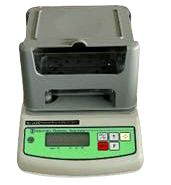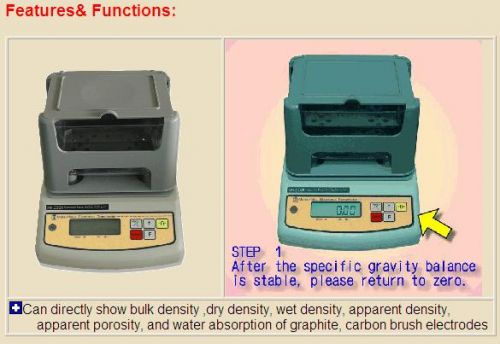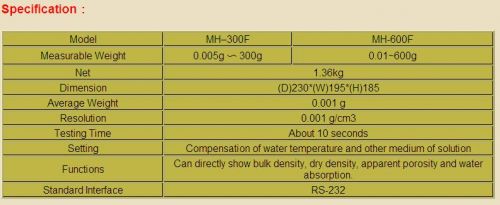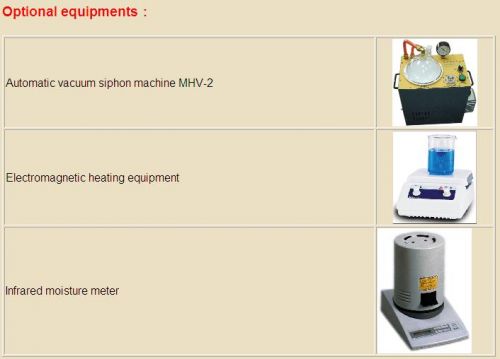
 |
| Densimeter เครื่องวัดความหนาแน่น Model 300F 600F
Electronic Densimeter for Graphite,Carbon,Refractory, Conductive materials เครื่องวัดความหนาแน่น ตะกั่ว MODEL : MH-300F /600F
Suitable For : Graphite, carbon, refractory, conductive materials, corrosion-resistant materials industries, new materials research lab Principle : In accordance with ASTM D 854-02,JIS、GB/T、ISOGB 2413,adopts the buoyancymethod of Archimedean principle, can measure the density accurately and fast.
Technical Data : - Carbon and graphite materials based on carbon-based non-metallic solid materials and carboon material are basically composed of a non-graphite carbon material. The graphite material is basically composed of carbon from the graphite material. Sometimes the carbon and graphite materials are commonly named as carbon material. - Graphite is one of cystalline mineral carnons, its color is back, crystal hexagonal plate, the general shaped show as thin slice or scaly, while the aggregation shows as earthy. As to aphanitic bode, it's soft and with low hardness, its Mohs hardness is about 1-2 the density is about 2.1-2.3. - Graphite electrode is a porous and absorbent product, its absorption abillity is strong, the porosity is also large. Its appearance density about 1.58-1.70, porosity about 20-29%. In order to measure electrode densification after sintering, always put the sintering electrodes into impregnation tank of asphalt. The results of densification is to improve the electrode strength, electrical resistance properties. - Graphite electrodes and carbon brushes on the density measurements have the following requirement A, bulk density method B, dry density method C, the wet density method.
|
 Matsuhaku Density TWS-300T Matsuhaku Density TWS-300T  Matsuhaku Density TWS-153T Matsuhaku Density TWS-153T  Matsuhaku Density TWS-214G Matsuhaku Density TWS-214G  Matsuhaku Density TWS-300LD Matsuhaku Density TWS-300LD  Matsuhaku Density TWS-300G Matsuhaku Density TWS-300G  Matsuhaku Density TWS-300BH Matsuhaku Density TWS-300BH  Matsuhaku Density TWS-153G Matsuhaku Density TWS-153G  Matsuhaku Density TWS-Large Size EL Matsuhaku Density TWS-Large Size EL  Matsuhaku Density TWS-Large Size E Matsuhaku Density TWS-Large Size E  Matsuhaku Density TWS-300E AND TWS-600E Matsuhaku Density TWS-300E AND TWS-600E  Matsuhaku Density TWS-214E Matsuhaku Density TWS-214E  Matsuhaku Density TWS-153E Matsuhaku Density TWS-153E  Matsuhaku Density TWS-1200E Matsuhaku Density TWS-1200E  Matsuhaku Density TWS-300 and 600PY Matsuhaku Density TWS-300 and 600PY  Matsuhaku Density TWS-300 and 600PM Matsuhaku Density TWS-300 and 600PM  Matsuhaku Density TWS-300 and 600PC Matsuhaku Density TWS-300 and 600PC  Matsuhaku Density TWS-214PY Matsuhaku Density TWS-214PY  Matsuhaku Density TWS-214PM Matsuhaku Density TWS-214PM  Matsuhaku Density TWS-214PC Matsuhaku Density TWS-214PC  Matsuhaku Density TWS-153PY Matsuhaku Density TWS-153PY  Matsuhaku Density TWS-153PM Matsuhaku Density TWS-153PM  Matsuhaku Density TWS-153PC Matsuhaku Density TWS-153PC  Matsuhaku Density TWS-1200PY Matsuhaku Density TWS-1200PY  Matsuhaku Density TWS-1200PM Matsuhaku Density TWS-1200PM  Matsuhaku Density TWS-1200PC Matsuhaku Density TWS-1200PC  Matsuhaku Density GP-300K and 600K Matsuhaku Density GP-300K and 600K  Matsuhaku Density GP-1200KN Matsuhaku Density GP-1200KN  Matsuhaku Density TWS-Super Large Size KL Matsuhaku Density TWS-Super Large Size KL  Matsuhaku Density TWS-Large Size K Matsuhaku Density TWS-Large Size K  Matsuhaku Density TWS-300 and 600K Matsuhaku Density TWS-300 and 600K  Matsuhaku Density TWS-214K Matsuhaku Density TWS-214K  Matsuhaku Density TWS-153K Matsuhaku Density TWS-153K  Matsuhaku Density TWS-1200K Matsuhaku Density TWS-1200K  Densimeter เครื่องวัดความหนาแน่น Model TS-300G Densimeter เครื่องวัดความหนาแน่น Model TS-300G  Densimeter เครื่องวัดความหนาแน่น Model TS-300E TS-600E Densimeter เครื่องวัดความหนาแน่น Model TS-300E TS-600E  Densimeter เครื่องวัดความหนาแน่น Model GP-120K 300K 600K 1200KN Densimeter เครื่องวัดความหนาแน่น Model GP-120K 300K 600K 1200KN  Densimeter เครื่องวัดความหนาแน่น Model QL-1200K QL-2000K QL-3000K Densimeter เครื่องวัดความหนาแน่น Model QL-1200K QL-2000K QL-3000K  Densimeter เครื่องวัดความหนาแน่น Lumber Basic Density Model GP-120W 1200WN MH-300W 600W Densimeter เครื่องวัดความหนาแน่น Lumber Basic Density Model GP-120W 1200WN MH-300W 600W  Densimeter เครื่องวัดความหนาแน่น Model GP-120S 300S 600S Densimeter เครื่องวัดความหนาแน่น Model GP-120S 300S 600S  Densimeter เครื่องวัดความหนาแน่น Model MH-300A 600A Densimeter เครื่องวัดความหนาแน่น Model MH-300A 600A  Densimeter เครื่องวัดความหนาแน่น Model GP-120E 300E 600E 1200EN Densimeter เครื่องวัดความหนาแน่น Model GP-120E 300E 600E 1200EN  Densimeter เครื่องวัดความหนาแน่น Model NH-300T Densimeter เครื่องวัดความหนาแน่น Model NH-300T  Densimeter เครื่องวัดความหนาแน่น Model MH-300Z 600Z Densimeter เครื่องวัดความหนาแน่น Model MH-300Z 600Z  Densimeter เครื่องวัดความหนาแน่น Model 300Y 600Y Densimeter เครื่องวัดความหนาแน่น Model 300Y 600Y  Densimeter เครื่องวัดความหนาแน่น Model 300N 600N Densimeter เครื่องวัดความหนาแน่น Model 300N 600N  Densimeter เครื่องวัดความหนาแน่น Model 300R 600R Densimeter เครื่องวัดความหนาแน่น Model 300R 600R  Densimeter เครื่องวัดความหนาแน่น Model MH-300I 600I Densimeter เครื่องวัดความหนาแน่น Model MH-300I 600I  Densimeter เครื่องวัดความหนาแน่น Model MH-300W 600W Densimeter เครื่องวัดความหนาแน่น Model MH-300W 600W  Densimeter เครื่องวัดความหนาแน่น Model MH-300J 600J Densimeter เครื่องวัดความหนาแน่น Model MH-300J 600J  Densimeter เครื่องวัดความหนาแน่น Model MH-300C 600C Densimeter เครื่องวัดความหนาแน่น Model MH-300C 600C  DENSIMETER, MH-300Q / 600Q DENSIMETER, MH-300Q / 600Q  DENSIMETER, MH-300P/600P DENSIMETER, MH-300P/600P  DENSIMETER, MH-300B/600B DENSIMETER, MH-300B/600B  DENSIMETER GS-300S DENSIMETER GS-300S  DENSIMETER,เครื่องวัดความหนาแน่นทอง DENSIMETER,เครื่องวัดความหนาแน่นทอง |









.jpg)

